A Comprehensive Report on the US-Canada Border Issues and Relations
VerifiedAdded on 2022/10/17
|9
|1928
|394
Report
AI Summary
This briefing note provides a comprehensive overview of the US-Canada border issues, examining the historical context, current situation, and potential improvements. The report highlights the strong alliance between the two countries, emphasizing their shared interests in defense, peace, and environmental protection. It delves into specific challenges such as the Safe Third Country Agreement, the flow of asylum seekers, and the impact of heightened border security measures. The document discusses various considerations, including trade, law enforcement collaboration, and preclearance agreements, while also addressing the sharing of traveler data. Recommendations include early threat addressal, trade facilitation, integrated law enforcement, and bolstering critical infrastructure and cybersecurity. The report underscores the importance of co-operative efforts to maintain international and internal peace and security.
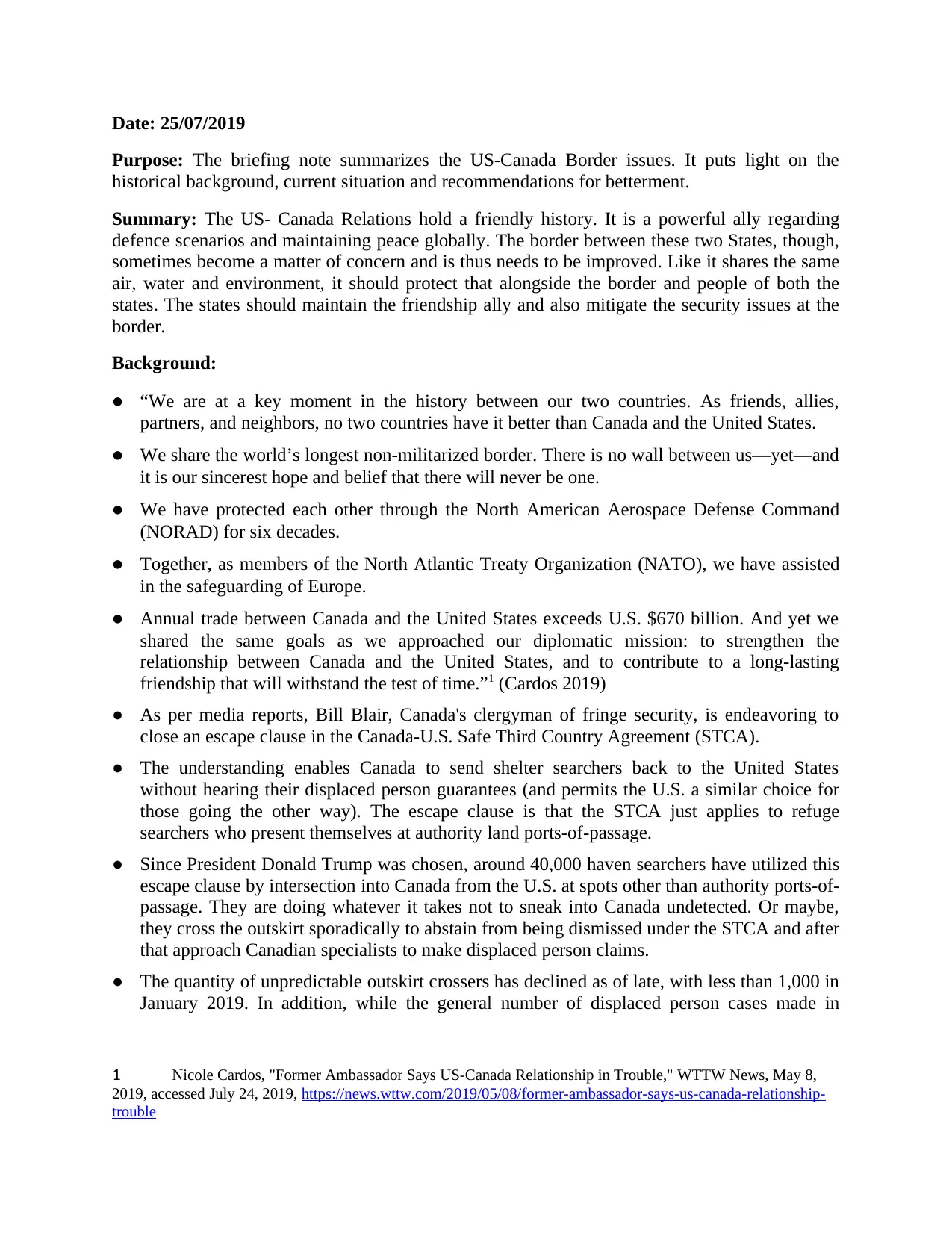
Date: 25/07/2019
Purpose: The briefing note summarizes the US-Canada Border issues. It puts light on the
historical background, current situation and recommendations for betterment.
Summary: The US- Canada Relations hold a friendly history. It is a powerful ally regarding
defence scenarios and maintaining peace globally. The border between these two States, though,
sometimes become a matter of concern and is thus needs to be improved. Like it shares the same
air, water and environment, it should protect that alongside the border and people of both the
states. The states should maintain the friendship ally and also mitigate the security issues at the
border.
Background:
● “We are at a key moment in the history between our two countries. As friends, allies,
partners, and neighbors, no two countries have it better than Canada and the United States.
● We share the world’s longest non‐militarized border. There is no wall between us—yet—and
it is our sincerest hope and belief that there will never be one.
● We have protected each other through the North American Aerospace Defense Command
(NORAD) for six decades.
● Together, as members of the North Atlantic Treaty Organization (NATO), we have assisted
in the safeguarding of Europe.
● Annual trade between Canada and the United States exceeds U.S. $670 billion. And yet we
shared the same goals as we approached our diplomatic mission: to strengthen the
relationship between Canada and the United States, and to contribute to a long‐lasting
friendship that will withstand the test of time.”1 (Cardos 2019)
● As per media reports, Bill Blair, Canada's clergyman of fringe security, is endeavoring to
close an escape clause in the Canada-U.S. Safe Third Country Agreement (STCA).
● The understanding enables Canada to send shelter searchers back to the United States
without hearing their displaced person guarantees (and permits the U.S. a similar choice for
those going the other way). The escape clause is that the STCA just applies to refuge
searchers who present themselves at authority land ports-of-passage.
● Since President Donald Trump was chosen, around 40,000 haven searchers have utilized this
escape clause by intersection into Canada from the U.S. at spots other than authority ports-of-
passage. They are doing whatever it takes not to sneak into Canada undetected. Or maybe,
they cross the outskirt sporadically to abstain from being dismissed under the STCA and after
that approach Canadian specialists to make displaced person claims.
● The quantity of unpredictable outskirt crossers has declined as of late, with less than 1,000 in
January 2019. In addition, while the general number of displaced person cases made in
1 Nicole Cardos, "Former Ambassador Says US-Canada Relationship in Trouble," WTTW News, May 8,
2019, accessed July 24, 2019, https://news.wttw.com/2019/05/08/former-ambassador-says-us-canada-relationship-
trouble
Purpose: The briefing note summarizes the US-Canada Border issues. It puts light on the
historical background, current situation and recommendations for betterment.
Summary: The US- Canada Relations hold a friendly history. It is a powerful ally regarding
defence scenarios and maintaining peace globally. The border between these two States, though,
sometimes become a matter of concern and is thus needs to be improved. Like it shares the same
air, water and environment, it should protect that alongside the border and people of both the
states. The states should maintain the friendship ally and also mitigate the security issues at the
border.
Background:
● “We are at a key moment in the history between our two countries. As friends, allies,
partners, and neighbors, no two countries have it better than Canada and the United States.
● We share the world’s longest non‐militarized border. There is no wall between us—yet—and
it is our sincerest hope and belief that there will never be one.
● We have protected each other through the North American Aerospace Defense Command
(NORAD) for six decades.
● Together, as members of the North Atlantic Treaty Organization (NATO), we have assisted
in the safeguarding of Europe.
● Annual trade between Canada and the United States exceeds U.S. $670 billion. And yet we
shared the same goals as we approached our diplomatic mission: to strengthen the
relationship between Canada and the United States, and to contribute to a long‐lasting
friendship that will withstand the test of time.”1 (Cardos 2019)
● As per media reports, Bill Blair, Canada's clergyman of fringe security, is endeavoring to
close an escape clause in the Canada-U.S. Safe Third Country Agreement (STCA).
● The understanding enables Canada to send shelter searchers back to the United States
without hearing their displaced person guarantees (and permits the U.S. a similar choice for
those going the other way). The escape clause is that the STCA just applies to refuge
searchers who present themselves at authority land ports-of-passage.
● Since President Donald Trump was chosen, around 40,000 haven searchers have utilized this
escape clause by intersection into Canada from the U.S. at spots other than authority ports-of-
passage. They are doing whatever it takes not to sneak into Canada undetected. Or maybe,
they cross the outskirt sporadically to abstain from being dismissed under the STCA and after
that approach Canadian specialists to make displaced person claims.
● The quantity of unpredictable outskirt crossers has declined as of late, with less than 1,000 in
January 2019. In addition, while the general number of displaced person cases made in
1 Nicole Cardos, "Former Ambassador Says US-Canada Relationship in Trouble," WTTW News, May 8,
2019, accessed July 24, 2019, https://news.wttw.com/2019/05/08/former-ambassador-says-us-canada-relationship-
trouble
Paraphrase This Document
Need a fresh take? Get an instant paraphrase of this document with our AI Paraphraser

Canada has been higher than expected in the previous two years, it isn't far-removed
authentic standards.
● Regardless, the extra 40,000 displaced person cases have created weights on the exile
assurance framework and on common social projects. There has additionally been political
pushback, with calls from the Conservative party for the legislature to stem the stream.
● Be that as it may, shutting the STCA escape clause is a muddled recommendation.
authentic standards.
● Regardless, the extra 40,000 displaced person cases have created weights on the exile
assurance framework and on common social projects. There has additionally been political
pushback, with calls from the Conservative party for the legislature to stem the stream.
● Be that as it may, shutting the STCA escape clause is a muddled recommendation.
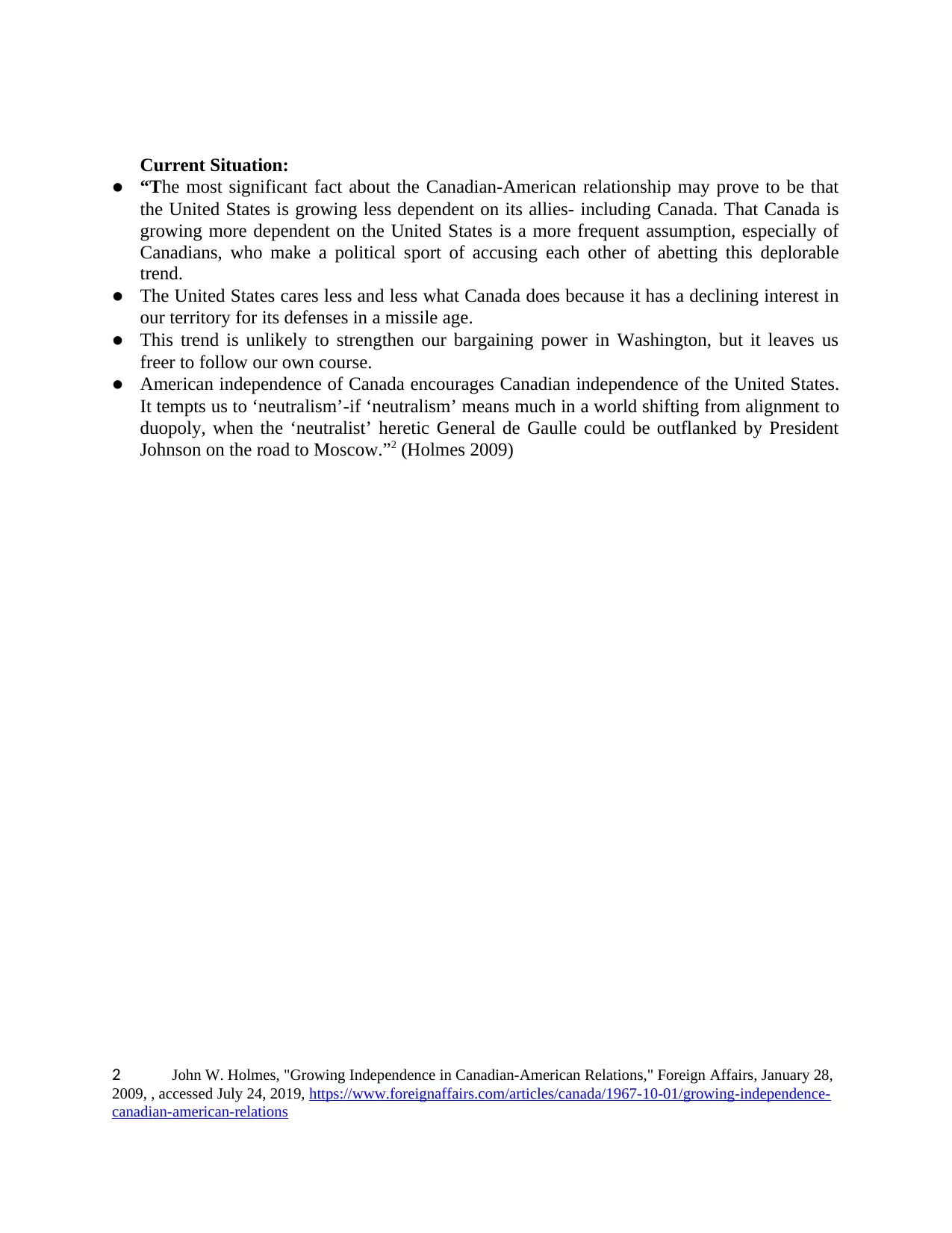
Current Situation:
● “The most significant fact about the Canadian-American relationship may prove to be that
the United States is growing less dependent on its allies- including Canada. That Canada is
growing more dependent on the United States is a more frequent assumption, especially of
Canadians, who make a political sport of accusing each other of abetting this deplorable
trend.
● The United States cares less and less what Canada does because it has a declining interest in
our territory for its defenses in a missile age.
● This trend is unlikely to strengthen our bargaining power in Washington, but it leaves us
freer to follow our own course.
● American independence of Canada encourages Canadian independence of the United States.
It tempts us to ‘neutralism’-if ‘neutralism’ means much in a world shifting from alignment to
duopoly, when the ‘neutralist’ heretic General de Gaulle could be outflanked by President
Johnson on the road to Moscow.”2 (Holmes 2009)
2 John W. Holmes, "Growing Independence in Canadian-American Relations," Foreign Affairs, January 28,
2009, , accessed July 24, 2019, https://www.foreignaffairs.com/articles/canada/1967-10-01/growing-independence-
canadian-american-relations
● “The most significant fact about the Canadian-American relationship may prove to be that
the United States is growing less dependent on its allies- including Canada. That Canada is
growing more dependent on the United States is a more frequent assumption, especially of
Canadians, who make a political sport of accusing each other of abetting this deplorable
trend.
● The United States cares less and less what Canada does because it has a declining interest in
our territory for its defenses in a missile age.
● This trend is unlikely to strengthen our bargaining power in Washington, but it leaves us
freer to follow our own course.
● American independence of Canada encourages Canadian independence of the United States.
It tempts us to ‘neutralism’-if ‘neutralism’ means much in a world shifting from alignment to
duopoly, when the ‘neutralist’ heretic General de Gaulle could be outflanked by President
Johnson on the road to Moscow.”2 (Holmes 2009)
2 John W. Holmes, "Growing Independence in Canadian-American Relations," Foreign Affairs, January 28,
2009, , accessed July 24, 2019, https://www.foreignaffairs.com/articles/canada/1967-10-01/growing-independence-
canadian-american-relations
⊘ This is a preview!⊘
Do you want full access?
Subscribe today to unlock all pages.

Trusted by 1+ million students worldwide
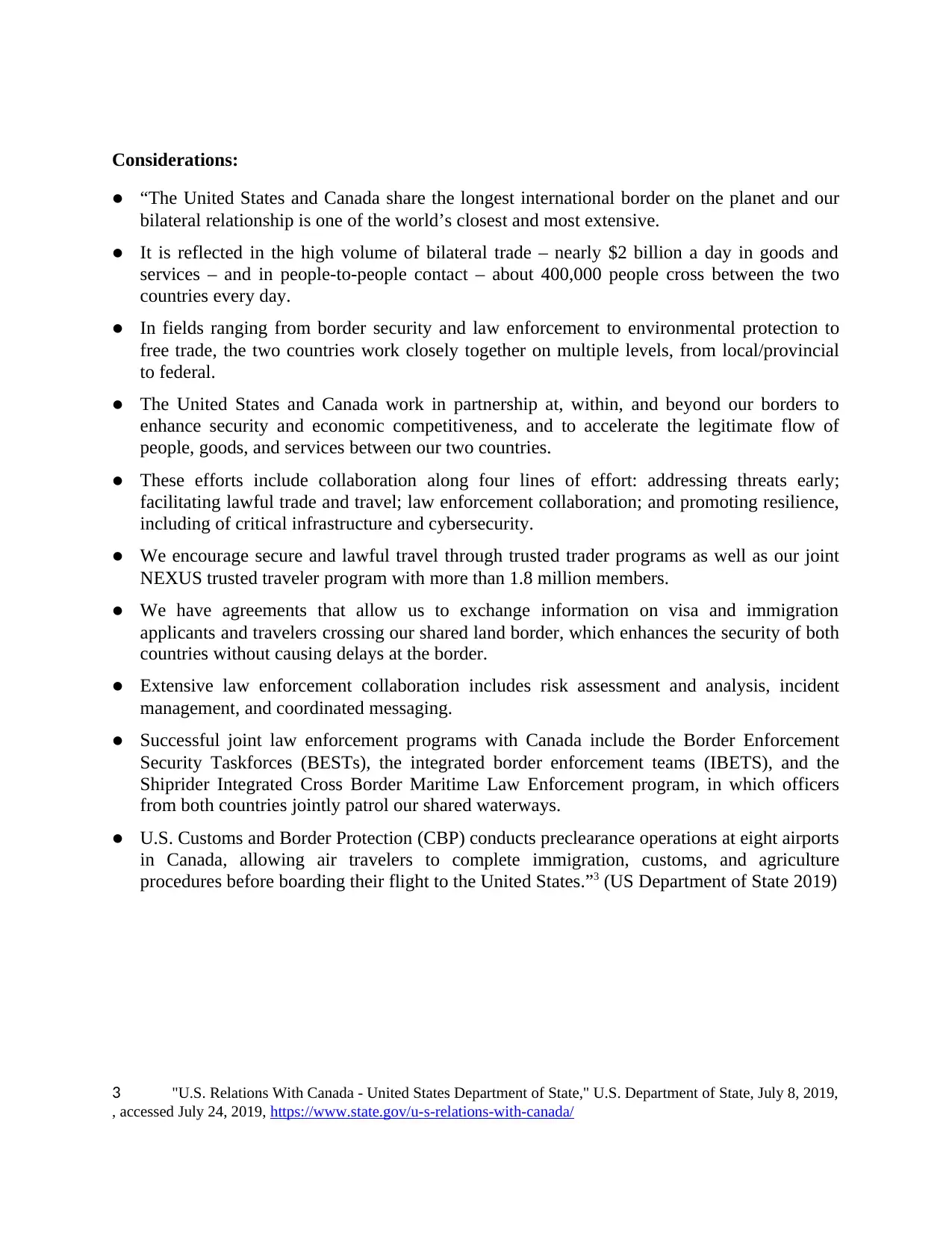
Considerations:
● “The United States and Canada share the longest international border on the planet and our
bilateral relationship is one of the world’s closest and most extensive.
● It is reflected in the high volume of bilateral trade – nearly $2 billion a day in goods and
services – and in people-to-people contact – about 400,000 people cross between the two
countries every day.
● In fields ranging from border security and law enforcement to environmental protection to
free trade, the two countries work closely together on multiple levels, from local/provincial
to federal.
● The United States and Canada work in partnership at, within, and beyond our borders to
enhance security and economic competitiveness, and to accelerate the legitimate flow of
people, goods, and services between our two countries.
● These efforts include collaboration along four lines of effort: addressing threats early;
facilitating lawful trade and travel; law enforcement collaboration; and promoting resilience,
including of critical infrastructure and cybersecurity.
● We encourage secure and lawful travel through trusted trader programs as well as our joint
NEXUS trusted traveler program with more than 1.8 million members.
● We have agreements that allow us to exchange information on visa and immigration
applicants and travelers crossing our shared land border, which enhances the security of both
countries without causing delays at the border.
● Extensive law enforcement collaboration includes risk assessment and analysis, incident
management, and coordinated messaging.
● Successful joint law enforcement programs with Canada include the Border Enforcement
Security Taskforces (BESTs), the integrated border enforcement teams (IBETS), and the
Shiprider Integrated Cross Border Maritime Law Enforcement program, in which officers
from both countries jointly patrol our shared waterways.
● U.S. Customs and Border Protection (CBP) conducts preclearance operations at eight airports
in Canada, allowing air travelers to complete immigration, customs, and agriculture
procedures before boarding their flight to the United States.”3 (US Department of State 2019)
3 "U.S. Relations With Canada - United States Department of State," U.S. Department of State, July 8, 2019,
, accessed July 24, 2019, https://www.state.gov/u-s-relations-with-canada/
● “The United States and Canada share the longest international border on the planet and our
bilateral relationship is one of the world’s closest and most extensive.
● It is reflected in the high volume of bilateral trade – nearly $2 billion a day in goods and
services – and in people-to-people contact – about 400,000 people cross between the two
countries every day.
● In fields ranging from border security and law enforcement to environmental protection to
free trade, the two countries work closely together on multiple levels, from local/provincial
to federal.
● The United States and Canada work in partnership at, within, and beyond our borders to
enhance security and economic competitiveness, and to accelerate the legitimate flow of
people, goods, and services between our two countries.
● These efforts include collaboration along four lines of effort: addressing threats early;
facilitating lawful trade and travel; law enforcement collaboration; and promoting resilience,
including of critical infrastructure and cybersecurity.
● We encourage secure and lawful travel through trusted trader programs as well as our joint
NEXUS trusted traveler program with more than 1.8 million members.
● We have agreements that allow us to exchange information on visa and immigration
applicants and travelers crossing our shared land border, which enhances the security of both
countries without causing delays at the border.
● Extensive law enforcement collaboration includes risk assessment and analysis, incident
management, and coordinated messaging.
● Successful joint law enforcement programs with Canada include the Border Enforcement
Security Taskforces (BESTs), the integrated border enforcement teams (IBETS), and the
Shiprider Integrated Cross Border Maritime Law Enforcement program, in which officers
from both countries jointly patrol our shared waterways.
● U.S. Customs and Border Protection (CBP) conducts preclearance operations at eight airports
in Canada, allowing air travelers to complete immigration, customs, and agriculture
procedures before boarding their flight to the United States.”3 (US Department of State 2019)
3 "U.S. Relations With Canada - United States Department of State," U.S. Department of State, July 8, 2019,
, accessed July 24, 2019, https://www.state.gov/u-s-relations-with-canada/
Paraphrase This Document
Need a fresh take? Get an instant paraphrase of this document with our AI Paraphraser
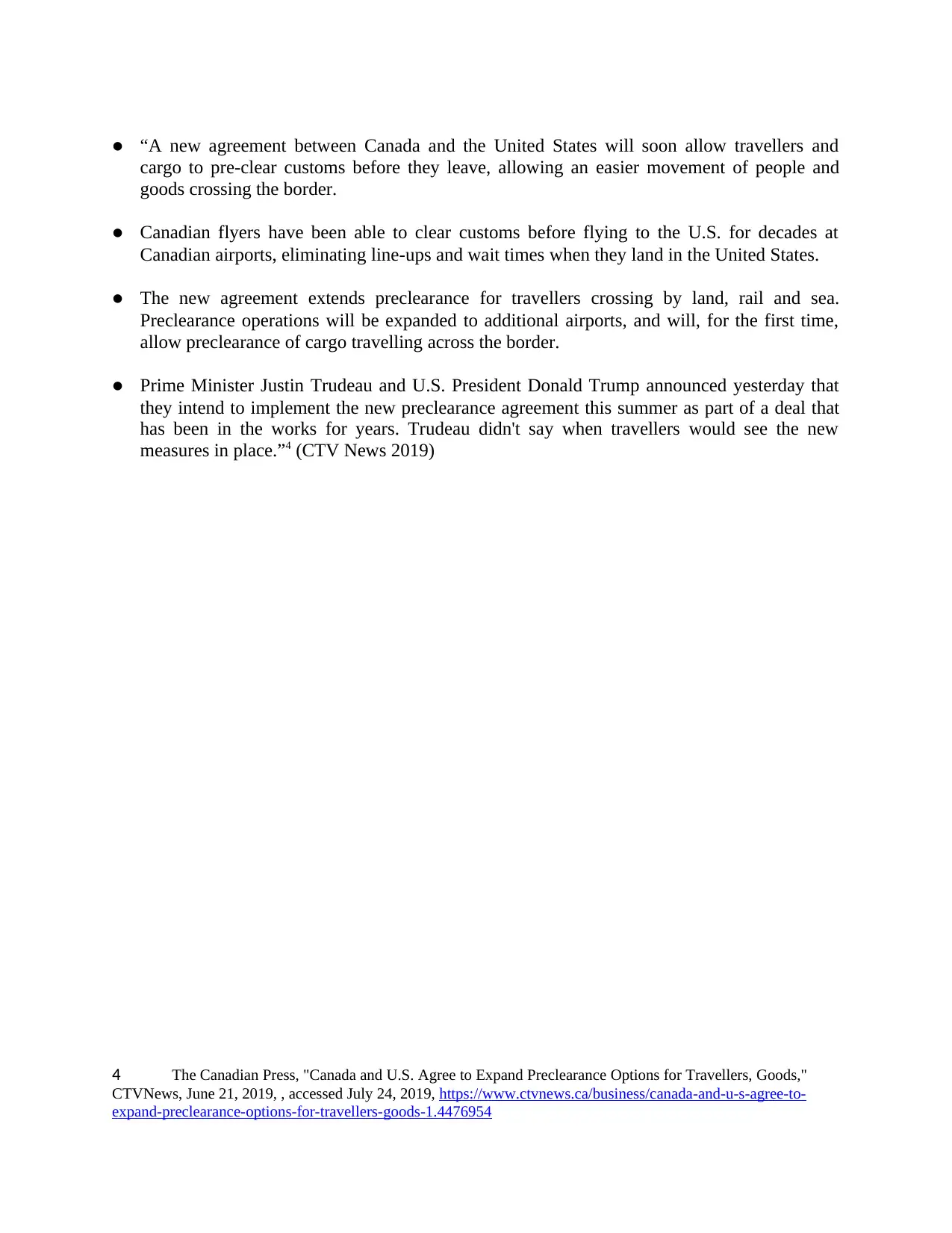
● “A new agreement between Canada and the United States will soon allow travellers and
cargo to pre-clear customs before they leave, allowing an easier movement of people and
goods crossing the border.
● Canadian flyers have been able to clear customs before flying to the U.S. for decades at
Canadian airports, eliminating line-ups and wait times when they land in the United States.
● The new agreement extends preclearance for travellers crossing by land, rail and sea.
Preclearance operations will be expanded to additional airports, and will, for the first time,
allow preclearance of cargo travelling across the border.
● Prime Minister Justin Trudeau and U.S. President Donald Trump announced yesterday that
they intend to implement the new preclearance agreement this summer as part of a deal that
has been in the works for years. Trudeau didn't say when travellers would see the new
measures in place.”4 (CTV News 2019)
4 The Canadian Press, "Canada and U.S. Agree to Expand Preclearance Options for Travellers, Goods,"
CTVNews, June 21, 2019, , accessed July 24, 2019, https://www.ctvnews.ca/business/canada-and-u-s-agree-to-
expand-preclearance-options-for-travellers-goods-1.4476954
cargo to pre-clear customs before they leave, allowing an easier movement of people and
goods crossing the border.
● Canadian flyers have been able to clear customs before flying to the U.S. for decades at
Canadian airports, eliminating line-ups and wait times when they land in the United States.
● The new agreement extends preclearance for travellers crossing by land, rail and sea.
Preclearance operations will be expanded to additional airports, and will, for the first time,
allow preclearance of cargo travelling across the border.
● Prime Minister Justin Trudeau and U.S. President Donald Trump announced yesterday that
they intend to implement the new preclearance agreement this summer as part of a deal that
has been in the works for years. Trudeau didn't say when travellers would see the new
measures in place.”4 (CTV News 2019)
4 The Canadian Press, "Canada and U.S. Agree to Expand Preclearance Options for Travellers, Goods,"
CTVNews, June 21, 2019, , accessed July 24, 2019, https://www.ctvnews.ca/business/canada-and-u-s-agree-to-
expand-preclearance-options-for-travellers-goods-1.4476954
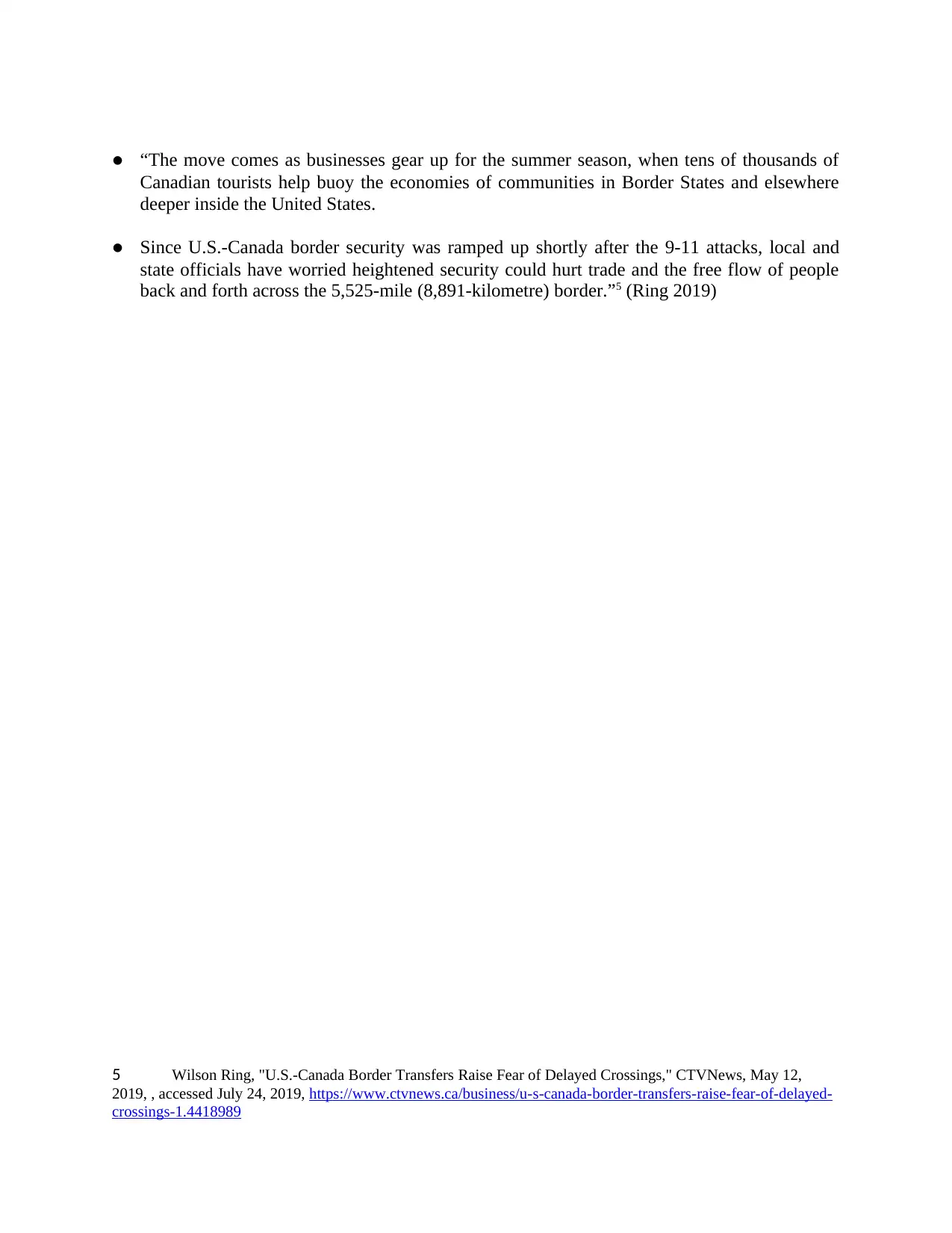
● “The move comes as businesses gear up for the summer season, when tens of thousands of
Canadian tourists help buoy the economies of communities in Border States and elsewhere
deeper inside the United States.
● Since U.S.-Canada border security was ramped up shortly after the 9-11 attacks, local and
state officials have worried heightened security could hurt trade and the free flow of people
back and forth across the 5,525-mile (8,891-kilometre) border.”5 (Ring 2019)
5 Wilson Ring, "U.S.-Canada Border Transfers Raise Fear of Delayed Crossings," CTVNews, May 12,
2019, , accessed July 24, 2019, https://www.ctvnews.ca/business/u-s-canada-border-transfers-raise-fear-of-delayed-
crossings-1.4418989
Canadian tourists help buoy the economies of communities in Border States and elsewhere
deeper inside the United States.
● Since U.S.-Canada border security was ramped up shortly after the 9-11 attacks, local and
state officials have worried heightened security could hurt trade and the free flow of people
back and forth across the 5,525-mile (8,891-kilometre) border.”5 (Ring 2019)
5 Wilson Ring, "U.S.-Canada Border Transfers Raise Fear of Delayed Crossings," CTVNews, May 12,
2019, , accessed July 24, 2019, https://www.ctvnews.ca/business/u-s-canada-border-transfers-raise-fear-of-delayed-
crossings-1.4418989
⊘ This is a preview!⊘
Do you want full access?
Subscribe today to unlock all pages.

Trusted by 1+ million students worldwide
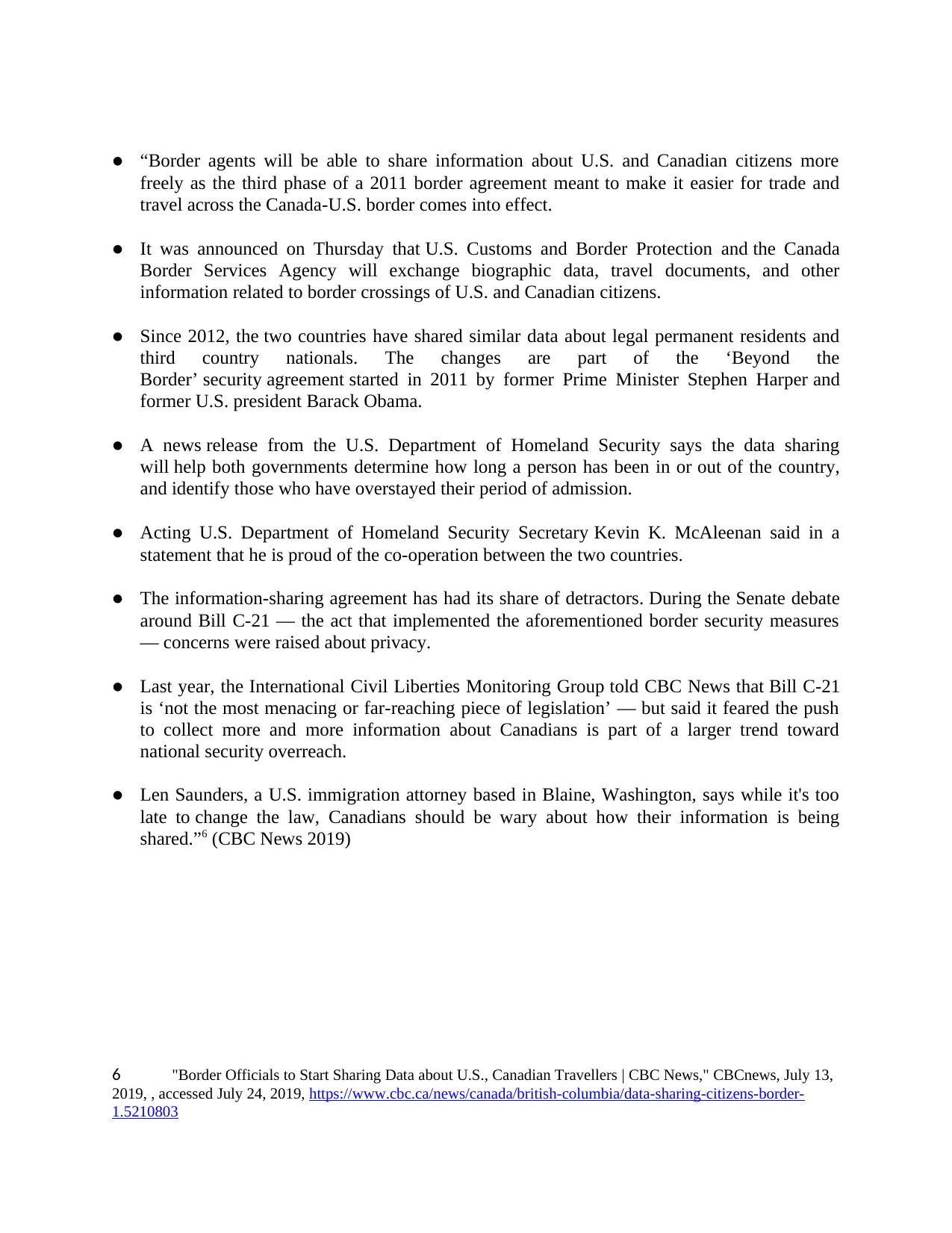
● “Border agents will be able to share information about U.S. and Canadian citizens more
freely as the third phase of a 2011 border agreement meant to make it easier for trade and
travel across the Canada-U.S. border comes into effect.
● It was announced on Thursday that U.S. Customs and Border Protection and the Canada
Border Services Agency will exchange biographic data, travel documents, and other
information related to border crossings of U.S. and Canadian citizens.
● Since 2012, the two countries have shared similar data about legal permanent residents and
third country nationals. The changes are part of the ‘Beyond the
Border’ security agreement started in 2011 by former Prime Minister Stephen Harper and
former U.S. president Barack Obama.
● A news release from the U.S. Department of Homeland Security says the data sharing
will help both governments determine how long a person has been in or out of the country,
and identify those who have overstayed their period of admission.
● Acting U.S. Department of Homeland Security Secretary Kevin K. McAleenan said in a
statement that he is proud of the co-operation between the two countries.
● The information-sharing agreement has had its share of detractors. During the Senate debate
around Bill C-21 — the act that implemented the aforementioned border security measures
— concerns were raised about privacy.
● Last year, the International Civil Liberties Monitoring Group told CBC News that Bill C-21
is ‘not the most menacing or far-reaching piece of legislation’ — but said it feared the push
to collect more and more information about Canadians is part of a larger trend toward
national security overreach.
● Len Saunders, a U.S. immigration attorney based in Blaine, Washington, says while it's too
late to change the law, Canadians should be wary about how their information is being
shared.”6 (CBC News 2019)
6 "Border Officials to Start Sharing Data about U.S., Canadian Travellers | CBC News," CBCnews, July 13,
2019, , accessed July 24, 2019, https://www.cbc.ca/news/canada/british-columbia/data-sharing-citizens-border-
1.5210803
freely as the third phase of a 2011 border agreement meant to make it easier for trade and
travel across the Canada-U.S. border comes into effect.
● It was announced on Thursday that U.S. Customs and Border Protection and the Canada
Border Services Agency will exchange biographic data, travel documents, and other
information related to border crossings of U.S. and Canadian citizens.
● Since 2012, the two countries have shared similar data about legal permanent residents and
third country nationals. The changes are part of the ‘Beyond the
Border’ security agreement started in 2011 by former Prime Minister Stephen Harper and
former U.S. president Barack Obama.
● A news release from the U.S. Department of Homeland Security says the data sharing
will help both governments determine how long a person has been in or out of the country,
and identify those who have overstayed their period of admission.
● Acting U.S. Department of Homeland Security Secretary Kevin K. McAleenan said in a
statement that he is proud of the co-operation between the two countries.
● The information-sharing agreement has had its share of detractors. During the Senate debate
around Bill C-21 — the act that implemented the aforementioned border security measures
— concerns were raised about privacy.
● Last year, the International Civil Liberties Monitoring Group told CBC News that Bill C-21
is ‘not the most menacing or far-reaching piece of legislation’ — but said it feared the push
to collect more and more information about Canadians is part of a larger trend toward
national security overreach.
● Len Saunders, a U.S. immigration attorney based in Blaine, Washington, says while it's too
late to change the law, Canadians should be wary about how their information is being
shared.”6 (CBC News 2019)
6 "Border Officials to Start Sharing Data about U.S., Canadian Travellers | CBC News," CBCnews, July 13,
2019, , accessed July 24, 2019, https://www.cbc.ca/news/canada/british-columbia/data-sharing-citizens-border-
1.5210803
Paraphrase This Document
Need a fresh take? Get an instant paraphrase of this document with our AI Paraphraser
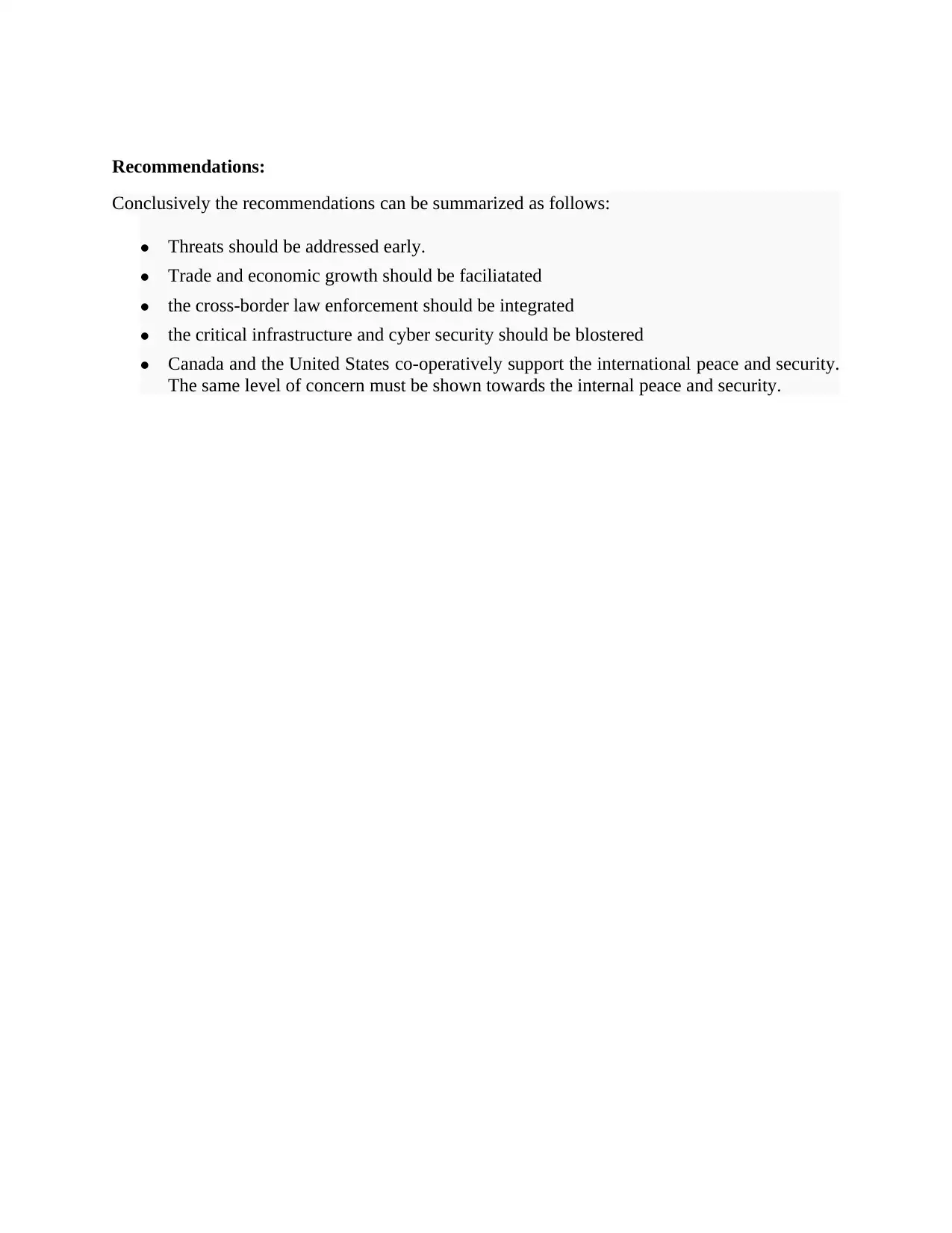
Recommendations:
Conclusively the recommendations can be summarized as follows:
● Threats should be addressed early.
● Trade and economic growth should be faciliatated
● the cross-border law enforcement should be integrated
● the critical infrastructure and cyber security should be blostered
● Canada and the United States co-operatively support the international peace and security.
The same level of concern must be shown towards the internal peace and security.
Conclusively the recommendations can be summarized as follows:
● Threats should be addressed early.
● Trade and economic growth should be faciliatated
● the cross-border law enforcement should be integrated
● the critical infrastructure and cyber security should be blostered
● Canada and the United States co-operatively support the international peace and security.
The same level of concern must be shown towards the internal peace and security.
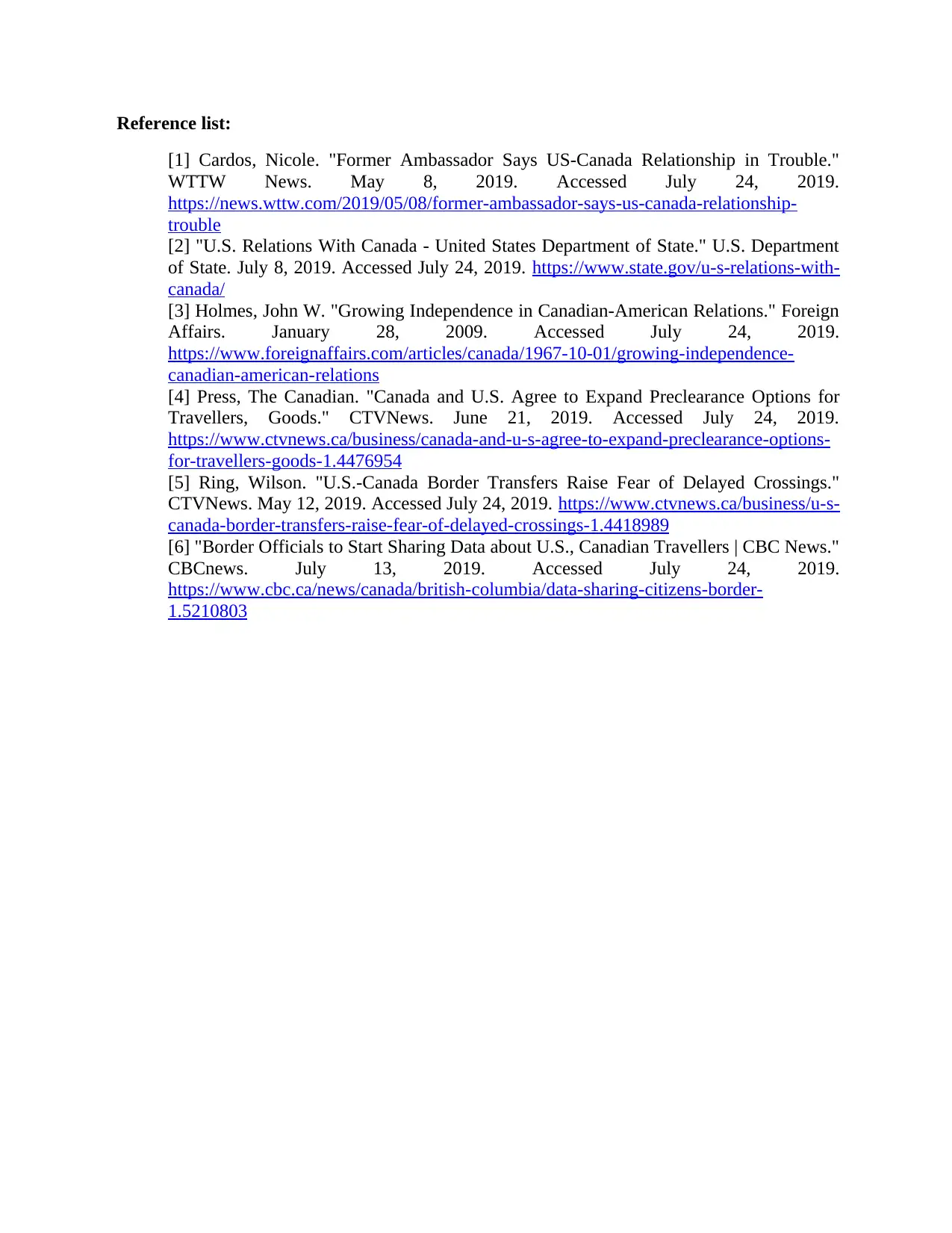
Reference list:
[1] Cardos, Nicole. "Former Ambassador Says US-Canada Relationship in Trouble."
WTTW News. May 8, 2019. Accessed July 24, 2019.
https://news.wttw.com/2019/05/08/former-ambassador-says-us-canada-relationship-
trouble
[2] "U.S. Relations With Canada - United States Department of State." U.S. Department
of State. July 8, 2019. Accessed July 24, 2019. https://www.state.gov/u-s-relations-with-
canada/
[3] Holmes, John W. "Growing Independence in Canadian-American Relations." Foreign
Affairs. January 28, 2009. Accessed July 24, 2019.
https://www.foreignaffairs.com/articles/canada/1967-10-01/growing-independence-
canadian-american-relations
[4] Press, The Canadian. "Canada and U.S. Agree to Expand Preclearance Options for
Travellers, Goods." CTVNews. June 21, 2019. Accessed July 24, 2019.
https://www.ctvnews.ca/business/canada-and-u-s-agree-to-expand-preclearance-options-
for-travellers-goods-1.4476954
[5] Ring, Wilson. "U.S.-Canada Border Transfers Raise Fear of Delayed Crossings."
CTVNews. May 12, 2019. Accessed July 24, 2019. https://www.ctvnews.ca/business/u-s-
canada-border-transfers-raise-fear-of-delayed-crossings-1.4418989
[6] "Border Officials to Start Sharing Data about U.S., Canadian Travellers | CBC News."
CBCnews. July 13, 2019. Accessed July 24, 2019.
https://www.cbc.ca/news/canada/british-columbia/data-sharing-citizens-border-
1.5210803
[1] Cardos, Nicole. "Former Ambassador Says US-Canada Relationship in Trouble."
WTTW News. May 8, 2019. Accessed July 24, 2019.
https://news.wttw.com/2019/05/08/former-ambassador-says-us-canada-relationship-
trouble
[2] "U.S. Relations With Canada - United States Department of State." U.S. Department
of State. July 8, 2019. Accessed July 24, 2019. https://www.state.gov/u-s-relations-with-
canada/
[3] Holmes, John W. "Growing Independence in Canadian-American Relations." Foreign
Affairs. January 28, 2009. Accessed July 24, 2019.
https://www.foreignaffairs.com/articles/canada/1967-10-01/growing-independence-
canadian-american-relations
[4] Press, The Canadian. "Canada and U.S. Agree to Expand Preclearance Options for
Travellers, Goods." CTVNews. June 21, 2019. Accessed July 24, 2019.
https://www.ctvnews.ca/business/canada-and-u-s-agree-to-expand-preclearance-options-
for-travellers-goods-1.4476954
[5] Ring, Wilson. "U.S.-Canada Border Transfers Raise Fear of Delayed Crossings."
CTVNews. May 12, 2019. Accessed July 24, 2019. https://www.ctvnews.ca/business/u-s-
canada-border-transfers-raise-fear-of-delayed-crossings-1.4418989
[6] "Border Officials to Start Sharing Data about U.S., Canadian Travellers | CBC News."
CBCnews. July 13, 2019. Accessed July 24, 2019.
https://www.cbc.ca/news/canada/british-columbia/data-sharing-citizens-border-
1.5210803
⊘ This is a preview!⊘
Do you want full access?
Subscribe today to unlock all pages.

Trusted by 1+ million students worldwide
1 out of 9
Your All-in-One AI-Powered Toolkit for Academic Success.
+13062052269
info@desklib.com
Available 24*7 on WhatsApp / Email
![[object Object]](/_next/static/media/star-bottom.7253800d.svg)
Unlock your academic potential
Copyright © 2020–2025 A2Z Services. All Rights Reserved. Developed and managed by ZUCOL.